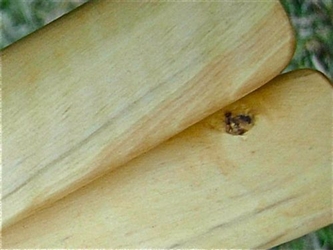 |
Boxwood
Boxwood is a hard, close-grained and heavy exotic evergreen native to England and Turkey that delivers a strong sharp tone.
This intriguing wood comes from a shrub that usually stands no higher than 3 feet at maturity and can take a century to reach a trunk diameter of 3 inches. Despite its small size, Boxwood produces extremely dense wood that is so heavy it barely floats.
Boxwood is a knotty wood noted for a creamy yellowish tan heartwood that is indistinguishable from the sapwood. The timber is a pale yellow when freshly cut, then slowly changes to a warm brownish yellow with exposure. The unusual wood exhibits a very fine uniform texture featuring a rich and satiny luster.
Bone Rattling Facts
Boxwood is used in delicate woodwork such as musical instruments, inlays and engraving blocks. It is also used to make authentic reproductions of vintage instruments such as bombards, hurdy-gurdys, and baroque flutes. The hard, dense wood is used for crafting clarinets and as a substitute for ivory. "The Greeks discovered that when it was used for wind instruments, there were few woods that possessed such a soft resonant tone as box," reports Luke Hughes in "The Encyclopedia of Wood."
Boxwood is the traditional wood for making croquet balls and mallet heads. President Rutherford B. Hayes spent six dollars of American taxpayer money on a set of fancy boxwood croquet balls. So it would seem the concussive impact quality of Boxwood would offer a natural advantage to bone rattling.
Cool Facts
Medicinal benefits include claims that the wood is diaphoretic (induces perspiration); treats epilepsy; relieves rheumatism and syphilis; works as a sedative; and yields an essential oil used in dentistry.
Dwarf English Boxwood is famous for its use in formal landscape design. Boxwood has been widely used as a landscape tree as far back as Biblical times because it is ideal for the art of topiary. Boxwood is used in wreaths, garlands, kissing balls and various topiary "tree" arrangements.
Boxwood fossils 22 million years old have been found in Europe. Its first known ornamental use occurred among the Egyptians about 4,000 B.C. "Man's oldest garden ornament" was introduced to North America from Europe using Boxwood brought over the Atlantic Ocean from Amsterdam. The first planting occurred about 1653 at Sylvester Manor on Shelter Island in the northwest part of Long Island in New York.
English Boxwood was brought to the Virginia Colony on tall-masted sailing ships during the 18th Century. The slow-growing English Boxwood can be seen at such national landmarks as the White House, Colonial Williamsburg, and Mount Vernon.
Figures below are approximate (but pretty darn close)
Tonality
Can't Decide Which Bones to Choose?
Check out this handy guide: Bone FAQs
Scroll down for technical Boxwood facts...
|
|
Boxwood Facts
Scientific Name
Buxus sempervirens (Suffruticosa)
The ancient Greeks and Romans used the wood to make decorative boxes. The Buxus in the scientific name means, "box" in Latin.
Other Names
Outside of the U.S., Boxwood shrubs are generally referred to simply as "box."
Box
Box Tree
Boxwood
Circassian Boxwood
Common Box
Dutch Box
Dwarf Box
Dwarf English Boxwood
European Box
Iranian Boxwood
Persian Boxwood
True Dwarf English Boxwood
Turkish Boxwood
There are about 90 species and over 150 different cultivars (plant varieties produced in cultivation by selective breeding). Other species botanically related to Boxwood include:
American Boxwood (Buxus sempervirens 'Arborescens')
Japanese Boxwood (Buxus microphylla ssp. japonica)
Balearic Boxwood (Buxus balearica)
Cape Boxwood (Buxus macowani)
Knysna Boxwood (Gonioma kamassi)
Maracaibo Boxwood (Gossypiospermum praecox)
San Domingo Boxwood (Phyllostylon brasiliensis)
East London Boxwood (Buxus macowani)
Lookalike Woods
Flowering Dogwood (Cornus florida), aka False Boxwood
White-topped Box (Eucalyptus quadrangulata)
Maple
Apple
Grain
Boxwood is described as close-grained. The grain is usually very straight, but can also be irregular.
Texture
This wood has a very fine and uniform texture. The texture is exceptionally smooth because of extremely small vessel cells.
Luster
The surface polishes to a rich and satiny luster.
Heartwood Color
Pale Yellowish Beige (Creamed English Tea)
Uniform light yellow color with streaks of tight grain as well as a few knots. The freshly cut creamy yellow wood turns to a warm brownish yellow over time.
Sapwood Color
The sapwood is indistinguishable from the heartwood.
Aroma
Freshly worked Boxwood releases an earthy fragrance.
Woodworking
Boxwood is a favorite among woodcarvers because it takes fine detail. Boxwood was widely used in 15th century Europe for engraving and printing. "English Boxwood is the king of carving stock, but rare and expensive," says one woodcarving enthusiast. "English Boxwood is...just a joy to use," says another, adding, "Boxwood is still the very nicest material I've used. Ivory comes in second."
Environmental Profile
Supplies of Boxwood are very limited and the price is high. Reports indicate that other species related to Boxwood are being offered on the market as substitutes.
Distribution
Boxwood is an evergreen shrub that grows in Southern Europe, Western Asia, and North America. The species range from Asia Minor across central Europe to south-east England. In England, the tree grows wild only at a few places where the soil is rich in lime. It can be found on limestone rocks and is highly tolerant of shade.
Tree Data
Boxwood is a shrub that usually stands no higher than 3 feet at maturity. The trunk can take a century to reach a trunk diameter of just 3 inches.
|
|
|